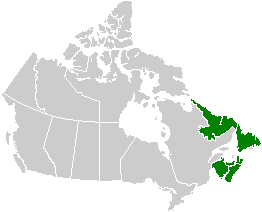Atlantic provinces
As the Atlantic provinces of Canada (English Atlantic provinces or Atlantic Canada , French provinces de l'Atlantique or Canada atlantique ) are the four easternmost states of the Canadian state that border directly and exclusively on the Atlantic Ocean .
From north to south these are Newfoundland and Labrador , Prince Edward Island , New Brunswick and Nova Scotia . The latter three are also known as Maritime Provinces (Engl. Maritime provinces , fr. Provinces maritimes ), respectively.
The census in 2016 showed 2,333,332 residents together for the four Atlantic provinces. The population density is extremely different. In Newfoundland and Labrador it is 1.4 inh / km² and in Prince Edward Island it is 25.1 inh / km². This is the lowest or highest population density in one of the Canadian provinces (only in the northern territories is the population density even lower).
history
The term was first used by Joey Smallwood , the first Prime Minister of the Province of Newfoundland and Labrador. After the accession of Newfoundland and Labrador to the Canadian state in 1949 , the citizens should be given the impression of a grown solidarity with the three neighboring provinces to the south that had been part of Canada for a long time (New Brunswick and Nova Scotia since 1867, Prince Edward Island since 1873).
Biggest cities
The list only includes cities with more than 25,000 inhabitants.
| city | province | Residents | ||
|---|---|---|---|---|
| Halifax | Nova Scotia | 403,390 | ||
| St. John's | Newfoundland and Labrador | 205.955 | ||
| Moncton | New Brunswick | 144.810 | ||
| Saint John | New Brunswick | 126.202 | ||
| Fredericton | New Brunswick | 101,760 | ||
| Cape Breton Regional Municipality | Nova Scotia | 98,722 | ||
| Charlottetown | Prince Edward Island | 65,523 | ||
| Truro | Nova Scotia | 45,753 | ||
| New Glasgow | Nova Scotia | 34,487 | ||
| Corner Brook | Newfoundland and Labrador | 31,917 | ||
| Bathurst | New Brunswick | 31,110 | ||
| Miramichi | New Brunswick | 27,523 | ||
| Kentville | Nova Scotia | 26,222 |
See also
Individual evidence
- ^ Population and dwelling counts, for Canada, provinces and territories, 2016 and 2011 censuses. In: Statistics Canada . February 20, 2019, accessed April 26, 2020 .
- ^ Population and dwelling counts, for Canada, provinces and territories, census metropolitan areas and census agglomerations, 2016 and 2011 censuses. In: Statistics Canada . February 20, 2019, accessed April 26, 2020 .
